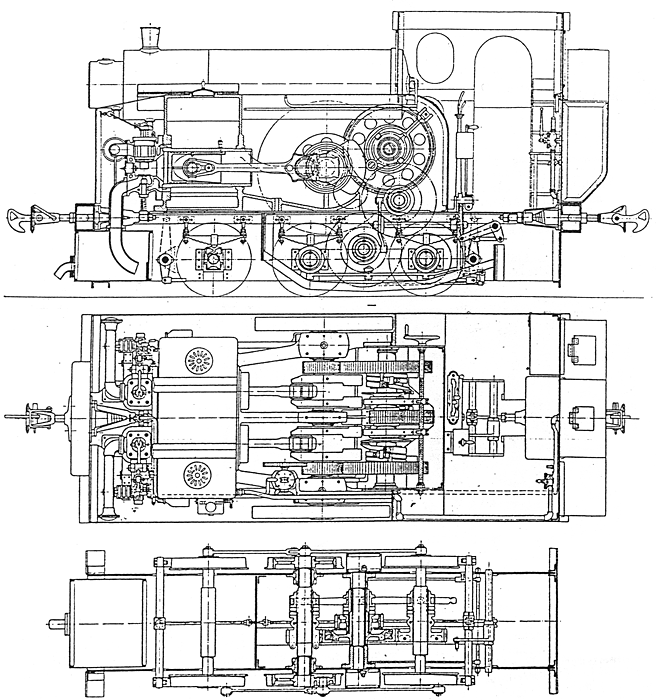Experimental Locomotive 259

|
SAR 259 was one of two "New Century" 3'6" gauge locomotives sent to Australia in 1913 (the other went to the Western Australian Public Works Department). They were built by Ruhrthaler Maschinenfabrik Schwarz & Dyckerhoff Gmbh of Mülheim/Ruhr, Germany. The sale was arranged through the dealer Ironside Sons & Dyckerhoff, which was actually a joint venture between Ruhrthaler and F.M.Hawthorn of London.
The SAR loco was Ruhrthaler b/n 163 of 1912, and it was shipped from Germany to Australia on the "Essinglen" on 30 May 1913. It was presumably transferred to the "Morialta" in Adelaide for on-forwarding to Port Lincoln, as it arrived there on that vessel at the end of July 1913. It officially entered service on 6 June 1914, more than ten months later.
|

Builder's photo of one of the New Century locos prior to shipment to Australia.
Photo: courtesy Jens Merte
|
The 'West Coast Recorder' of 6th August 1913 carried this account of the arrival of 259 in Port Lincoln:
"A New Engine, For the Darke's Peak Line.
"There arrived in Port Lincoln by the Morialta on Wednesday last an engine entirely different to anything previously seen in the Commonwealth, and its appearance has evoked considerable interest, as there is the probability it will revolutionize the present system of propelling railway engines by steam. The new arrival is of a most peculiar design compared to the usual class of engine in vogue, and its square-shaped body and low wheels gives one the impression that it is not a very fast engine but rather designed for drawing heavy loads. The engine now is minus several important parts but a fair idea can be gauged of what be its appearance when it is complete.
"Mr T. A. Kingdon, Chief Engineer, was very courteous in explaining to our reporter what he knew of the internal combustion engine having had no previous experience in the new style. The weight is approximately 22 1/2 tons. and is driven by kerosine, 130 test, after a start has been made with benzine. It has double cylinders and high horse power engines, and the diameter of the wheels are 27 inches. The necessary levers are handy for the driver's use, and doubtless only one man will be needed to manipulate the whole concern. The intended idea of this new engine, which is imported from Germany, is to run it on the Darke's Peak line. The engines at present in use on that section consumed five trucks of water on the run, and as only ten laden trucks can be taken on that section on account of the gradients the settlers only receive five trucks of water every trip. The distinct advantage of the new engine which uses little or no water can be clearly seen, and if the idea is as good as it is expected it will be the engine that will do the best service on this dry section. The engine, with 10 laden trucks, will, it is hoped, attain a speed of 10 or 12 miles an hour, which will be sufficient when it is considered that it will have a weight of about 100 tons to draw. Although only as an experiment it is hoped the resourcefulness of the Railway Department will prove a great success, as the settlers will receive the benefits, and the innovation shows an evident desire to keep pace with time."
Of note in this account is the reference to the engine being started on benzine (a form of petrol), then running when warm on 'power' kerosine. This practice was common with many early farm tractors, continuing as late as the 1950s.
In 1912 construction of the Minnipa Hill and Darke's Peak lines was under way. The SAR would have known at this time that adequate supplies of suitable water on these lines were going to be hard to come by. The internal combustion locomotive being considered by the SAR had the potential to alleviate this situation, so Port Lincoln was an obvious testing ground for a prototype. In that year the SAR took the bold step of ordering the prototype internal combustion locomotive, which became no. 259. If successful, it could have resulted in the replacement of steam power on Eyre Peninsula and other lines forty years before main line internal combustion locomotives came to prominence in Australia. History shows however that the experiment was a complete failure, and after a single aborted main line test run in 1915, no. 259 never ran again. It was officially condemned on 13 July 1923, and one report states that its motor ended up providing power for machinery at Islington Railway Workshops in Adelaide.
For more details of no. 259 and its inglorious career, see Peninsula Pioneer, pages 215-219.
Construction Diagrams
The plans below, sourced from the Ruhrthaler archives by Jens Merte, throw considerable light on the internal workings of this unusual locomotive, with the two cylinders and the large flywheels being prominent. They also explain the unusual shape of the bodywork.

Plans: courtesy Jens Merte
Acknowledgements and further references
Special thanks to Jens Merte, Tony Presgrave, Dave Parsons, John Browning and Gerald Petrie for the 'pieces of the puzzle'. Jens has much information available on
Ruhrthaler
and on
locomotive building in Germany.



